After twelve years of photographing birds and paying particular attention to their behaviors it isn’t every day that I witness a ritualized aggressive behavior that’s new to me. But it happened yesterday at Bear River MBR with a couple of Great Blue Herons, seemingly on steroids.
- The following photos are documentary in nature and many of them leave a lot to be desired. The action was quick and unexpected and I was too close with the lens I was using to include both birds in most of the shots. In one series in all the excitement I had my lens severely tilted and I don’t have enough room in the frame to level the images. In addition I had bad luck – I was swapping my teleconverter on and off and even using another lens and camera combo at times but twice when the most crucial behaviors were going down I was fiddling with my gear so I missed those shots. And then when I got home I had a memory card malfunction and lost a few of my images (especially those that included both birds). I know – excuses, excuses. But they’re my excuses and I’m using them…
- All photos are presented in the order they were taken. I didn’t have time to include image techs.
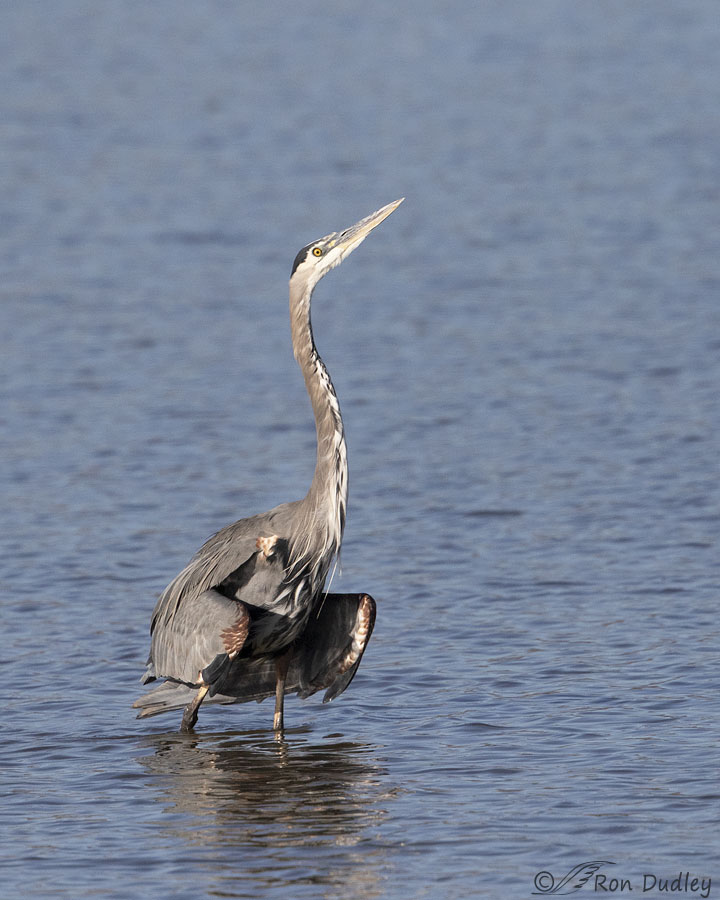
When I first saw the two Great Blue Herons they were already displaying and interacting with each other but I was going the wrong way on the auto tour route on the refuge so I had to turn around and come back.
This one seemed to be the most aggressive of the two but neither bird was backing down. What I was seeing was obviously a ritualized display with this bird’s neck almost fully extended vertically, its head pointed upward and its wings held away from its body and drooping down. Often one wing was lower than the other and this pose was held for a long time
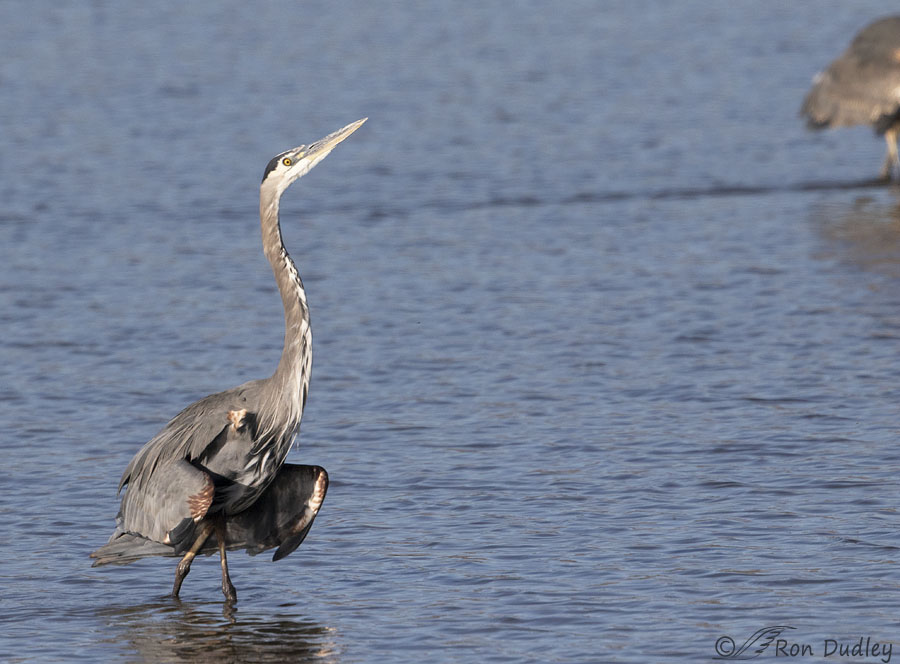
I’m including this photo so you can see the proximity of the two herons to each other. When it was taken the other bird was looking away but…
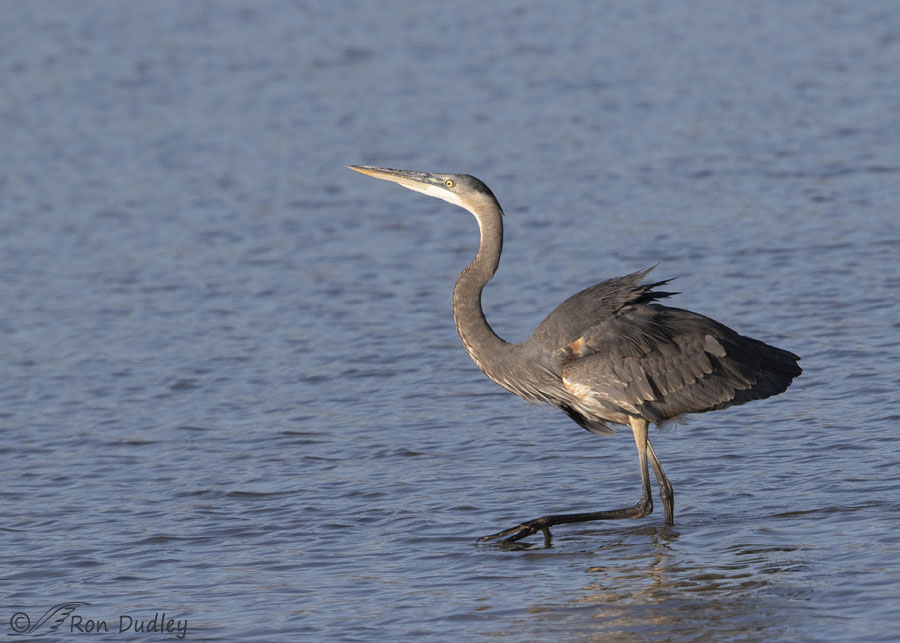
for much of the time it was looking directly at its rival and sometimes slowly approaching the other bird.
Here they had changed their location on the water slightly but the behavior was continuing. By now the most aggressive bird had lowered its left wing to the point it was dragging in the water.
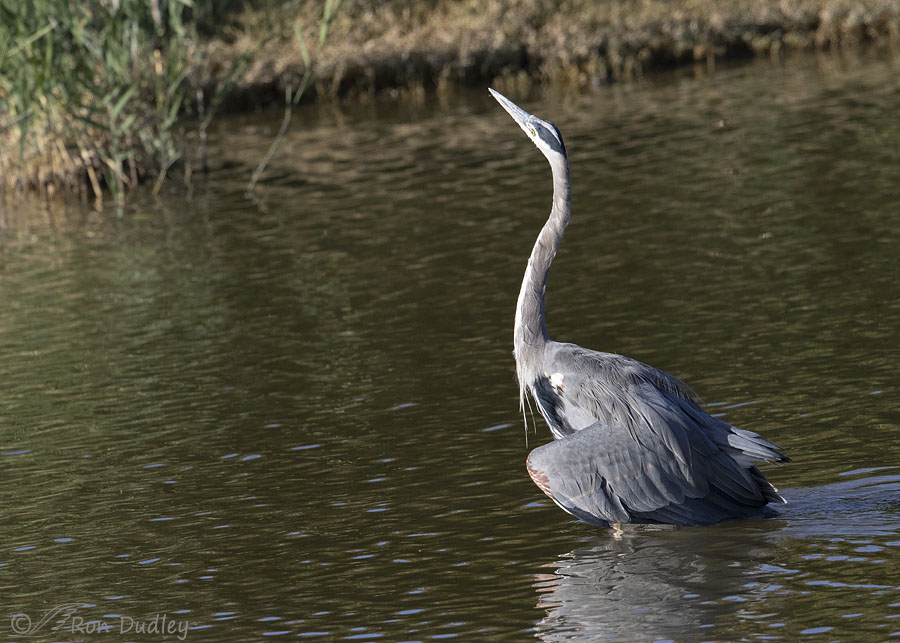
At times this heron’s head was pointed straight up but I’m not including any of those shots because its face and eye were always in shade. This is the steepest head angle I got with light on the face. Notice that the left wing in particular is still drooping.
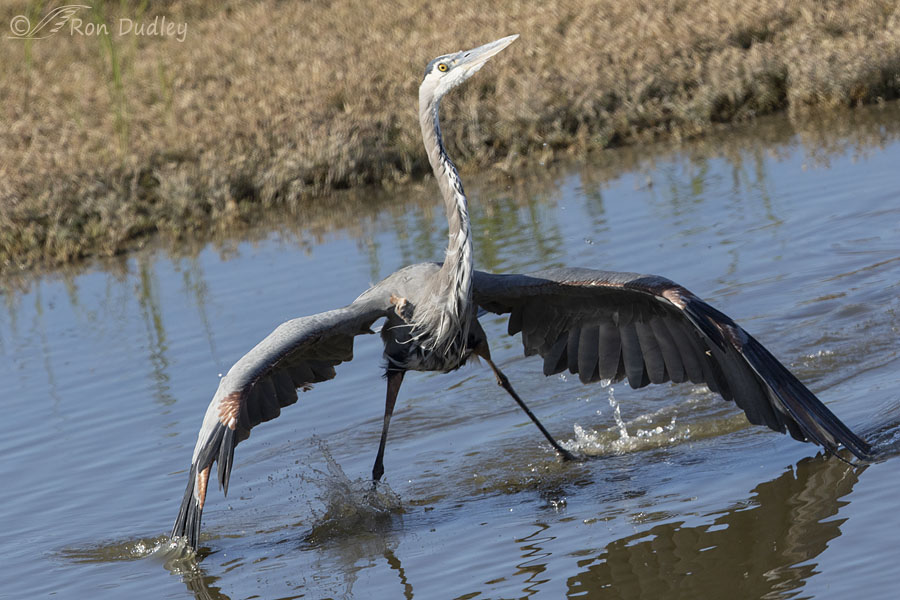
Suddenly all hell broke loose in my viewfinder. This bird assumed an extreme threat posture and danced around in the water as it was displaying toward the other heron out of frame to the right. In the excitement I’d severely tilted my lens but I couldn’t level the image in processing without losing too much of the bird – this image as presented is full frame (uncropped).
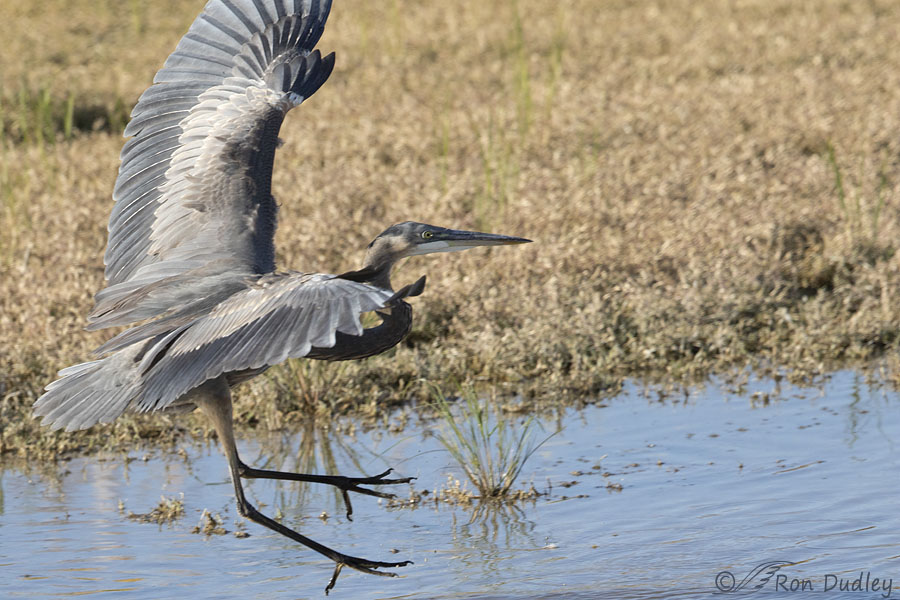
The most aggressive heron flew at the other one…
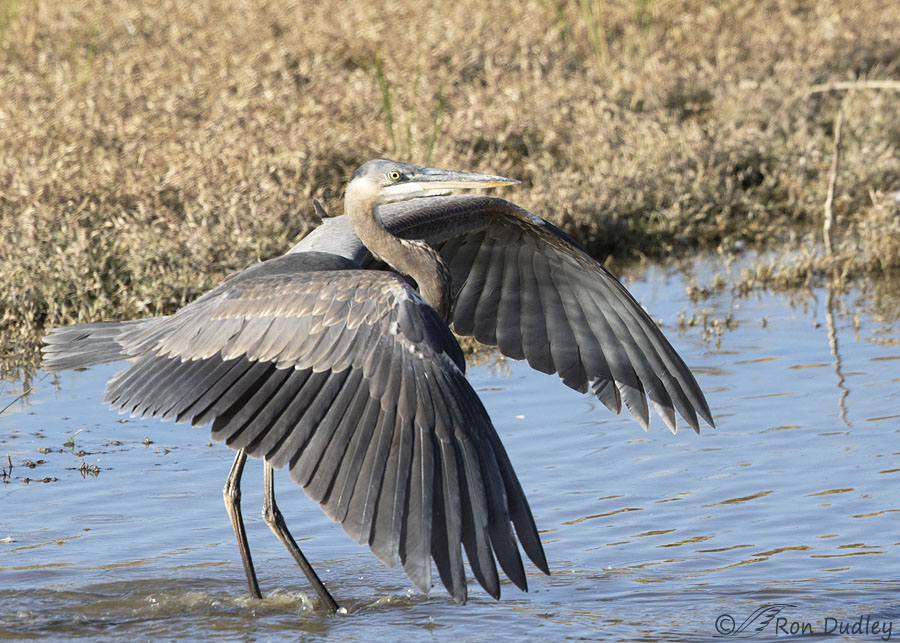
but stopped short in the water to assume yet another very aggressive threat posture…
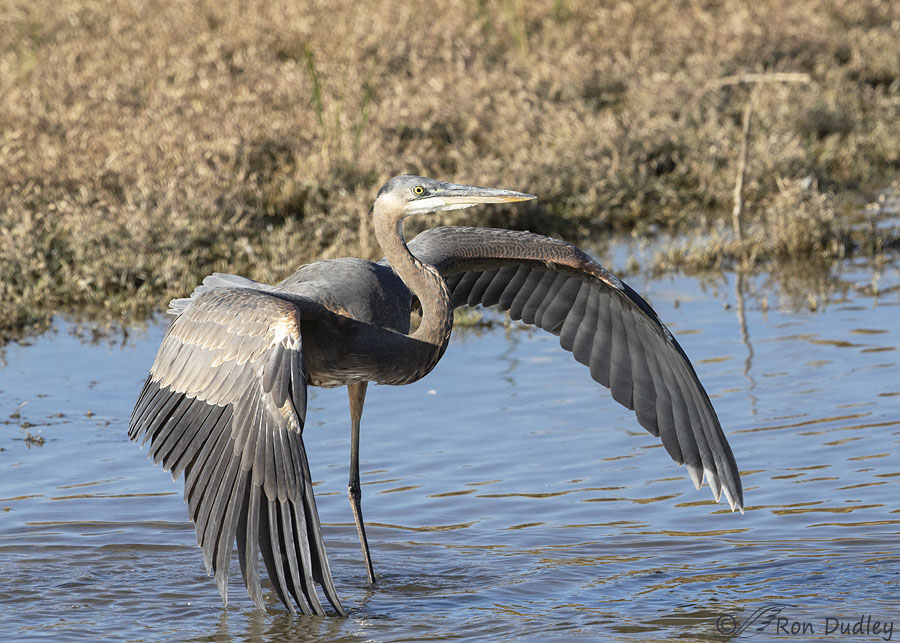
which it maintained for a few moments.
I believe it was at this point that I made my fateful mistake. They were likely about to fight and there was no way I could keep both huge fighting birds in the frame with my long lens so I reached over to grab my smaller zoom lens. While I was fiddle-farting around with my gear they rushed at each other, skirmished briefly (I think, though I was looking mostly away when it happened), and then separated with the apparent loser flying off.
I’ve seen Great Blue Herons displaying aggressively and fighting before but this ritualized, almost choreographed display was new to me so I did a little research on Cornell’s Birds of North America Online. What I saw in the field seems to closely match what BNA calls their “Upright and Spread Wing Display”. I’ve quoted BNA verbatim below:
- “The most spectacular display given by herons on the foraging grounds is the Upright and Spread Wing display that is given when two herons approach one another. The neck is nearly fully extended and tilted slightly over the back, the head and bill are held above the horizontal, and the wrists are drooped or held away from the body exposing the black shoulder patch of the adult. Sometimes the wing nearest the opponent is drooped lower than the opposite wing and the body plumes are erected. As opponents approach one another, the head and bill are raised closer to the vertical and the neck extended farther over the back. These displays usually cause the two herons to move apart but occasionally bring a chase. This display is sometimes directed towards gulls (Larus sp.), Great Egrets (Casmerodius albus), and even people.”
I wish I could have a do-over with these herons so I could keep my teleconverter off of my big lens the entire time and so I’d know precisely when to switch to my smaller zoom lens but bird photography doesn’t work that way. I’ll have to be satisfied with experiencing the behavior and getting the photos I did.
But I do wish I could just say “Take Two” like a movie director and have another go at it.
Ron
PS – I’d be interested in knowing if any of my readers have seen this precise behavior in Great Blue Herons.


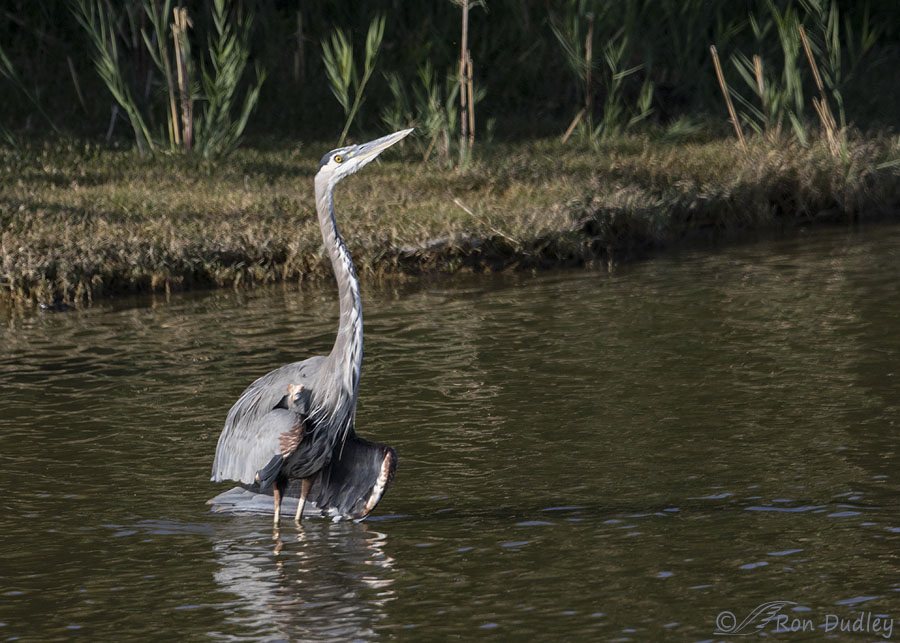
Ron, thank you for these exciting action shots. I’ve never seen a Blue Heron. The long neck and bill and huge wing spread are quite interesting. When herons fight it must be exciting and scary to watch.
Just WOW! That’s all I’ve got to say. What a shame you missed so much while fiddle farting, but so it goes. That’s life! I am always heartened in that skirmishes generally don’t last long with one or the other combatants realizing that discretion is the better part of survival to fight another day! 😉
Thanks, Laura. Yes, with that dagger-like bill discretion is the better part of any conflict with that species…
How amazing. I wish you had been able to say Take Two as well, but am blown away by what you DID capture. A documentary I will scroll through again as soon as I hit publish.
I am intrigued that the dropped wing is part of the display too. My ignorant self would have thought that two raised wings were more threatening. It seems I am wrong. Again.
EC, BNA seems to imply that exposing the black shoulder patch (which is revealed when the wing is dropped) has some meaning to the species. Thank you.
That is so interesting. I rarely see Heron’s together, so I have never seen that type of behavior. Thank goodness you didn’t witness a full fledged fight.
Thanks Ron!
Thanks, Jean.
Mag. Ni. Fi. Cent. I’m with Mary — the tilt-a-whirl shot is my fave and definitely wall-worthy. The intensity gives me the willies. That must have been quite the sight to see! Color me chartreuse!
The GBHs I see around here a of the more languid variety. Nobody’s getting their knickers in a twist in my neighborhood. Well, except for Coots, but that’s what they do. 😉
It certainly was a “sight to see”, Marty. I sure butchered a lot of my shots of it though. I was just too close with that big lens.
Yes, I’ve seen this behavior a few times – and Monday, I watched two great egrets (Ardea alba) do something similar on a patch of productive water (posted to my FB page Tuesday). Most fishermen of the Homo sapiens species are nicer to each other about the same patch of water. . On the other hand, around here, we also have a great blue and a great egret who are pals, pick each other up in the morning to go to work, fish together, roost together. . . Damn, we love hanging around with birds. . .
Interesting that your two birds of different species seem to be so friendly, Martha. Something I’ve never seen.
WOW! I’ve never seen that! 🙂 Of course, Murphy had to get involved……:( Glad you were able to watch it AND capture some of the behavior. Almost looks like in the 4th and 6th photos that the Heron has an injury right next to it’s chest on the right side or is that just how they are? Wind howling in advance of the storm Friday…… Early for THAT bad and scurrying with last minute preps…
That’s just a normal feather pattern, Judy.
Yes, I have a friend farming north of Cut Bank who has been scrambling to get all their grain harvested before that storm hits. Theirs is a big operation – they’ve had 7 custom cutter combines going for almost two weeks now (with pauses for poor harvesting conditions). Sounds like it’s going to be lots of snow up there and they’ve had to dump all their barley on the ground temporarily. But at least they finally got it all harvested yesterday.
Excellent documentary series. Like you, I wish you’d caught the actual brief fight. It may be that what you caught was more interesting. I’ve never witnessed anything like this. Is the food source more limited than usual? I’m wondering why it became an issue.
I don’t think food is more of an issue than usual, Nancy. Herons and egrets don’t seem to be having trouble catching fish.
I like the extreme tilt of the shot with the spread wing display. It emphasizes the action! Like the Bam-Pow frame in a comic book.
Interesting point comparing it to that kind of frame in a comic book, Mary.
Excellent series Ron. I have seen the extremely arched neck as in the first two photos, but for whom it was intended was not close and nothing ever occurred. When I am at Lynx Lake here especially if it has been recently stocked, there are often twenty or more GBH’s, but I have never seen any confrontations such as this. The funniest thing I ever saw with them was a very angry Bald Eagle chase one who had gotten in the way of a fish the eagle was about to swoop down on. The eagle shot down at the heron and the heron flew off all the way to the other side of the lake with the eagle in pursuit, but fortunately there never was contact. The heron kept flying and the eagle peeled off and flew to another perch. And of course Murphy is often present when there is action happening, but you need to switch cameras or put in a new battery etc.
Thanks, Everett. I’ve only seen a confrontation between those two species once.
SPECTACULAR! I wondered—do the birds vocalize at all during this behavior ? It looks as if these postures would consume a great deal of physical energy to maintain……
I’m guessing they’re territorial/dominance in intent–wrong time of year for mating displays, right ?
Kris, no I never heard any vocalization (until one of them was flying off) and BNA doesn’t mention vocalizing in this context.
Right, I believe this was a dispute over fishing rights.
I’ve never seen anything like it in the many GBH’s Ive seen through the years. Spectacular displays and behavior and fantastic catching it this well.
You must have gone nuts when they exploded while you were switching cameras. How do they always know when to outfox the photographer?
Looking at that spearlike bill broadside is pretty intimidating.
Really enjoyed your descriptions of the action both in front of and behind the lens. Cornell’s written description painted a very accurate picture as well, but it wouldn’t be real without your images.
“How do they always know when to outfox the photographer?”
That’s so very, VERY true, Dave! I try to be rational and logical about the reason it happens so often but it’s very hard to avoid thinking the do it just out of meanness to the photographer…
Oh my, are you one lucky person! I’ve never witnessed anything as such. A few years ago I came across a scene of one standing as in your last photo and there with one I could see had flown off but I never would have imagined the confrontation you witnessed. Great morning excitement to get the adrenalin moving. Oh the interactions we miss…glad you captured this one.
Kathy, it sounds like you just missed the first part of this particular behaver but saw the end of it. I wish I’d been with these birds from the beginning of their interaction so I’d know what I missed.
I’ve never seen the behavior. I’ll bet it was thrilling though.
It certainly was exciting, Arwen. And frustrating at the same time but I’m sure glad I was able to witness it.
WOW, excellent documentary shots. I’ve seen some of this behavior and marvel that you were able to capture it! Great job!
Thank you, Dick.